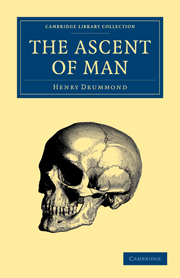Book contents
- Frontmatter
- Preface
- Contents
- THE ASCENT OF MAN
- INTRODUCTION
- CHAPTER I THE ASCENT OF THE BODY
- CHAPTER II THE SCAFFOLDING LEFT IN THE BODY
- CHAPTER III THE ARREST OF THE BODY
- CHAPTER IV THE DAWN OF MIND
- CHAPTER V THE EVOLUTION OF LANGUAGE
- CHAPTER VI THE STRUGGLE FOR LIFE
- CHAPTER VII THE STRUGGLE FOR THE LIFE OF OTHERS
- CHAPTER VIII THE EVOLUTION OF A MOTHER
- CHAPTER IX THE EVOLUTION OF A FATHER
- CHAPTER X INVOLUTION
CHAPTER I - THE ASCENT OF THE BODY
Published online by Cambridge University Press: 05 October 2010
- Frontmatter
- Preface
- Contents
- THE ASCENT OF MAN
- INTRODUCTION
- CHAPTER I THE ASCENT OF THE BODY
- CHAPTER II THE SCAFFOLDING LEFT IN THE BODY
- CHAPTER III THE ARREST OF THE BODY
- CHAPTER IV THE DAWN OF MIND
- CHAPTER V THE EVOLUTION OF LANGUAGE
- CHAPTER VI THE STRUGGLE FOR LIFE
- CHAPTER VII THE STRUGGLE FOR THE LIFE OF OTHERS
- CHAPTER VIII THE EVOLUTION OF A MOTHER
- CHAPTER IX THE EVOLUTION OF A FATHER
- CHAPTER X INVOLUTION
Summary
The earliest home of Primitive Man was a cave in the rocks—the simplest and most unevolved form of human habitation. One day, perhaps driven by the want within his hunting-grounds of the natural cave, he made himself a hut—an artificial cave. This simple dwelling-place was a one-roomed hut or tent of skin and boughs, and so completely does it satisfy the rude man's needs that down to the present hour no ordinary savage improves upon the idea. But as the hut surrounds itself with other huts and grows into a village, a new departure must take place. The village must have its chief, and the chief, in virtue of his larger life, requires a more spacious home. Each village, therefore, adds to its one-roomed huts, a hut with two rooms. From the two-roomed hut we pass, among certain tribes, to three- and four-roomed huts, and finally to the many-chambered lodge of the Head-Chief or King.
This passage from the simple cave to the many-chambered lodge is an Evolution, and a similar development may be traced in the domestic architecture of all civilized societies. The labourer's cottage of modern England and the shieling of the Highland crofter are the survivals of the one-roomed hut of Primitive Man, scarcely changed in any essential with the lapse of years. In the squire's mansion also, and the nobleman's castle, we have the representatives, but now in an immensely developed form, of the many-roomed home of the chief.
- Type
- Chapter
- Information
- The Ascent of Man , pp. 75 - 97Publisher: Cambridge University PressPrint publication year: 2009First published in: 1894



